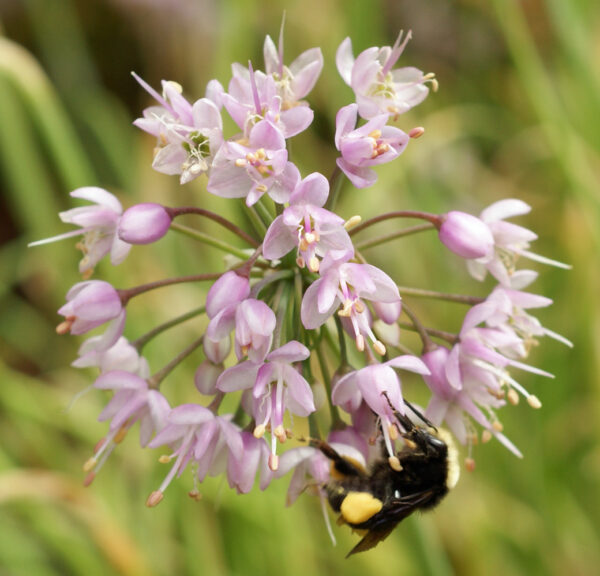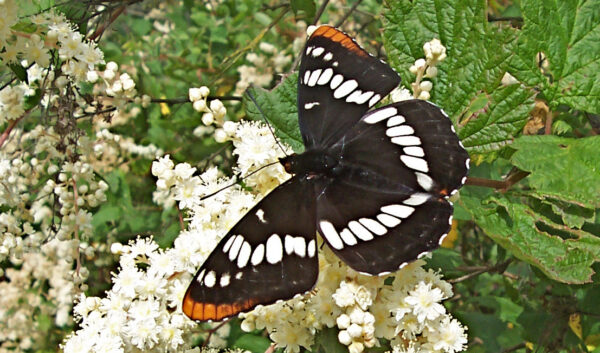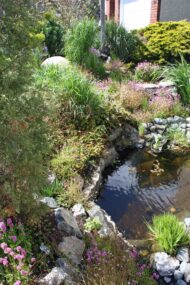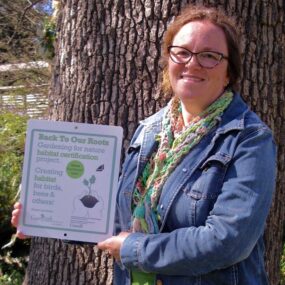Back to Our Roots (2014–2018)

Native plants benefit bees and vice versa (photo by Louise Goulet)
Back to Our Roots was a habitat certification program that provided on-site expert advice, resources, technical assistance, and incentives to help landowners plan and complete “naturescape” projects. The approach and certification was designed for small townhouse lots, large rural properties, and everything in-between. The program ran from 2014 to 2018.
Benefits of the Project
Nature faces many threats, especially in urban areas. Habitat loss, pesticides, synthetic fertilizers, and competition from invasive species are a few of the key challenges.
The Back to Our Roots project worked with property owners to help nature by:
- adding beautiful native plants to their landscaping;
- providing food, water and shelter for wild creatures, especially birds, bees, butterflies, and other pollinators;
- reducing water consumption;
- reducing the use of synthetic fertilizers and pesticides;
- managing invasive species;
- and creating native plant buffers and corridors around and between parks that have natural habitat and rare species.

Oceanspray shrubs attract birds, bees, and butterflies, such as this Lorquin”s Admiral (photo by Todd Carnahan)
What We Provided
- Minimum 1 hour free, on-site consultation with a native plant expert to provide advice and help plan the project.
- Ongoing naturescaping advice and resources.
- Incentives.
- Yard signs to explain the project and level of certification achieved.
Why Certify?

(photo by Louise Goulet)
Some gardeners found that a certification process helped them set priorities when planning and developing their naturescaping projects. The certification signs also explained a project to neighbours, spreading understanding and encouragement for gardening with native plants.
Our Back To Our Roots certification program was based on lot size categories, with two levels within each category (Green and Gold). During the site assessment visit, our representative helped determine which certification criteria were the best match for a space:
- for LARGE lots (planting area more than 100 m²)
- for MEDIUM lots (planting area 10–100 m²)
- for SMALL lots, townhouses, patio homes (planting area less than 10 m²)
Participants

Marie Fidoe proudly displays her Level 1 Green certification sign (photo by Chris Junck)
Marie Fidoe was the first landowner to sign on to the Back To Our Roots Project in 2015. Marie weeded, mulched, and prepared areas of her large Esquimalt yard, then added native plants that were recommended by our naturescaping expert Pat Johnston during an on-site consultation.
In 2016, Marie’s property was the first to be assessed for certification. She was elated to discover that she had achieved the requirements for Level 1 Green certification. Marie commented that Back To Our Roots was “a great, easy homeowner geared program. I appreciate the knowledge and encouragement.”
The project’s manager Chris Junck noted that “The interest level in the program is growing steadily, and the new naturescapers are very positive about the information and advice they’re receiving.” By 2018, the program had over 70 participants and over 50 properties. The properties ranged in size from small lots to over eight acres, and many were near parks and protected areas that have rare plants.
Project Funders
GOERT is grateful for the generous support that the project received for the program from:
- Environment Canada’s Habitat Stewardship Program
- The Capital Regional District Parks & Environmental Services
- The Victoria Foundation Community Grant